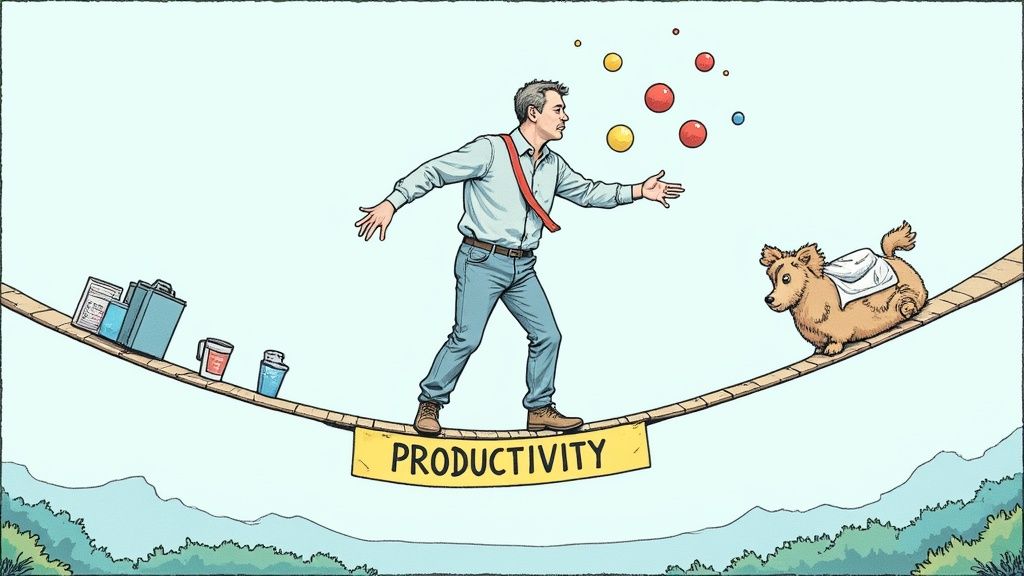How to Overcome Procrastination: A Science-Backed Guide for Breaking Free from Inaction


Understanding the Psychology of Procrastination
To efectively overcme procastrination, we need to look beyound simple willpowr and examine what actualy drives this behavoir. By understanding the brain's task procesing mechansms, we can better identify what triggrs our avoidnce responces.
The Role of Emotions in Procrastination
Procrastination stems more from emotional management than laziness. When we face tasks that make us anxious, afraid of failure, bored, or overwhelmed, we tend to put them off. This temporary escape provides brief relief but ultimately makes the negative emotions stronger. A good example is writing a complex report - the scope of the work creates anxiety, leading to delays. As the deadline gets closer, the mounting pressure only intensifies those anxious feelings.
The Prefrontal Cortex and Executive Function
Our brain's command center, the prefrontal cortex, plays a central role in task management and decision-making. This region handles executive functions like planning, setting priorities, and starting tasks. During procrastination, the emotional limbic system overrides the prefrontal cortex, making us choose short-term emotional comfort over our long-term goals.
Chronic vs. Occasional Procrastination
While most people occasionally delay tasks, chronic procrastination is a more serious pattern. Research shows that 20-25% of people chronically procrastinate, consistently putting off tasks in ways that harm their wellbeing. This ongoing pattern often connects to mental health challenges like depression, anxiety and poor sleep habits. You can learn more about procrastination prevalence and impacts here.
By seeing procrastination as an issue of emotional regulation rather than just time management, we can develop better strategies to address its root causes. Understanding these psychological factors helps create more effective approaches for staying on track with our goals.
Mastering Digital Focus in a Distracted World

Finding balance between productivity and digital distractions is one of the biggest challenges we face. That quick social media check can easily turn into an hour of scrolling, pushing important work further down our to-do list. Understanding how to use technology purposefully while avoiding its pitfalls is key to breaking the procrastination cycle.
Taming the Notification Beast
The first step to regaining focus is taking control of notifications. Every ping and buzz fragments our attention and breaks our concentration. Instead of responding to notifications as they come in, set specific times to check them. This simple change lets you create uninterrupted blocks for focused work and deeper thinking.
Creating Digital Boundaries
Clear boundaries around technology use make a big difference. Set specific times for checking email and social media. Create tech-free zones in your home - keeping devices out of the bedroom can improve sleep quality and reduce late-night scrolling. Website blockers and app limits during work hours can provide extra support when willpower isn't enough.
Leveraging Technology for Focus
Technology itself isn't the enemy - it can be a powerful tool when used intentionally. Many apps now include "focus modes" to minimize distractions. The Pomodoro technique, with focused work periods followed by short breaks, can be especially effective. The impact of digital distractions is significant: 50.7% of adults use the internet to procrastinate, spending 1.59 hours daily on non-essential activities. For students, social media is particularly challenging - 45% spend 6-8 hours per day on these platforms, while 23% spend over 8 hours. Learn more about procrastination patterns here: Find detailed procrastination statistics. With awareness of these patterns, we can make more conscious choices about our technology use and harness its benefits while avoiding its downsides.
The Five-Minute Revolution: Breaking Tasks Into Conquerable Steps

When you're stuck procrastinating on an important task, sometimes the hardest part is simply getting started. That's where the five-minute rule comes in - a straightforward but powerful technique that can help you overcome inaction and build momentum.
The Power of Small Beginnings
The concept is simple: commit to working on a task for just five minutes. This tiny time commitment makes even the most daunting projects feel manageable. Like pushing a heavy object, the initial push requires the most effort - but once you're in motion, it becomes much easier to keep going.
Consider writing a lengthy business proposal. Rather than feeling paralyzed by the scope of the entire project, you decide to write for just five minutes. This small step feels doable, and once you begin, you'll often find yourself naturally continuing beyond that initial time block.
Building Momentum and Maintaining Focus
Small wins create powerful forward momentum. Each five-minute block you complete reinforces positive action and weakens procrastination's hold. The clear time boundary also helps sharpen your focus - when you know you only need to concentrate for five minutes, it's easier to tune out distractions. The sense of progress you gain from completing these short sessions encourages you to keep going.
Adapting the Technique for Different Tasks
The five-minute approach works for many types of projects:
Creative Projects: Start with five minutes of free brainstorming, then move to five minutes of organizing those ideas
Administrative Tasks: Begin by sorting emails for five minutes, then spend five minutes responding to priority messages
Complex Assignments: Use five minutes to research one aspect, followed by five minutes outlining key points
Overcoming Initial Resistance
Even five minutes can feel challenging at first. Here are practical ways to make starting easier:
Match the task with something pleasant: Put on music you enjoy while tackling those five minutes
Picture the end result: Focus on how relieved you'll feel once the task is underway
Give yourself small rewards: Celebrate completing each five-minute block to build positive associations
While not a complete solution to procrastination, the five-minute rule offers a practical way to break through mental barriers and build productive momentum. By reducing overwhelming projects into brief, manageable segments, you can steadily move forward and accomplish your goals one small step at a time.
Crafting Your Personal Productivity Framework

Getting past procrastination requires more than just individual techniques - you need a complete system that works for you. Let's explore how to build a productivity framework that matches your unique work style, common roadblocks, and preferred tools.
Identifying Your Peak Performance Times
We all have certain hours when we naturally feel more focused and energetic. Pay attention to when you do your best work and plan accordingly. For instance, if you're sharpest in the morning, tackle your most demanding projects then instead of checking email. Understanding and working with your natural peak performance periods makes it much easier to stay on track.
Choosing the Right Productivity Methodologies
Several proven systems can help structure your work:
Timeboxing: Setting specific time blocks for each task
Getting Things Done (GTD): A method for capturing and organizing everything on your plate
The Eisenhower Matrix: Sorting tasks by both urgency and importance
Try different approaches to find what clicks with your style. Often, combining elements from multiple systems works best.
Building Your Personalized System
Creating an effective framework starts with understanding what gets you moving and what holds you back. Consider these key elements:
Task Management Tools: What format works best for you - digital lists, project software, or paper planners?
Accountability Methods: Would you benefit from a work buddy, study group, or progress-tracking app?
Rewards: How can you motivate yourself by celebrating both small wins and major milestones?
Tracking Progress and Staying Accountable
Regular check-ins help maintain momentum and refine your approach over time. Review your goals weekly, celebrate progress, and adjust tactics that aren't working. When you notice certain situations consistently trigger procrastination, add specific strategies to your framework to handle them. Small improvements compound into lasting change. Be patient with yourself and keep tweaking your system until it feels natural.
Breaking Through Perfectionism and Fear Barriers
When it comes to getting work done, perfectionism and fear can create a vicious cycle that keeps us stuck. These emotional barriers often prevent us from even starting tasks, much less completing them. The good news is that by understanding how these patterns work, we can develop practical ways to move past them.
Understanding the Link Between Perfectionism and Procrastination
Perfectionism creates unrealistic standards that can trigger intense anxiety about not measuring up. This anxiety often leads us to avoid tasks completely - we mistakenly think that not trying protects us from failure or criticism. Consider a common work scenario: You need to create an important presentation but keep putting it off because you worry it won't be good enough. This delay usually results in rushing at the last minute, leading to lower quality work that reinforces those perfectionist fears. As Adam Grant noted, "the task you're putting off isn't always the one you hate. It might be the one you fear. The one that's worth pursuing."
Reframing Negative Thought Patterns
One effective way to combat perfectionism is to actively challenge self-defeating thoughts. Rather than fixating on flaws, focus on what you've accomplished so far. For example, instead of thinking "This presentation isn't good enough," try "I've completed several slides and gathered solid data - I'm making progress." This simple shift can help reduce anxiety and maintain momentum. When fear crops up, take a short break to reset, then focus on just the next small step.
Embracing the "Minimum Viable Product" Concept
The software development concept of a minimum viable product (MVP) offers a helpful framework for managing perfectionism. The idea is to create a basic working version first, then improve it based on feedback and testing. This approach lets you learn and make progress without getting paralyzed by the pursuit of perfection. As one expert observed, "The desire for perfection often leads to procrastination. Learning to accept imperfection is the best way forward."
Setting Realistic Standards and Celebrating Progress
Another key to overcoming perfectionist procrastination is setting achievable goals. Break large projects into smaller, manageable chunks. This makes the work feel less overwhelming and creates natural opportunities to celebrate small wins, which builds confidence and momentum. Taking consistent action, even in small steps, compounds over time into major progress. Set clear deadlines to create urgency and prevent endless delays on open-ended projects.
By recognizing our fears, reframing negative self-talk, and focusing on steady progress, we can break free from perfectionism's grip. Building a mindset focused on growth and learning, rather than flawless execution, helps us move forward despite uncertainty. Remember that small steps add up - you don't have to do everything perfectly to make meaningful progress toward your goals.
Building Lasting Change: Your Success Blueprint

Breaking free from procrastination requires more than quick fixes - it needs a solid system that stands the test of time. Success comes from understanding habit formation, measuring progress, and staying focused even when things get tough.
The Science of Habit Formation
Every habit follows a simple pattern called the habit loop: it starts with a cue, leads to a routine, and ends with a reward. Think about feeling stressed by a big project (cue), checking social media for distraction (routine), and getting temporary relief (reward). Breaking this cycle means finding better routines. Instead of reaching for your phone, try breaking down the project into smaller tasks and celebrating each small win.
Designing Your Environment for Success
Your surroundings shape your actions more than you might think. Creating environmental triggers can naturally guide you toward better choices. For example, set up a clean workspace away from distractions, or leave your gym clothes by your bed to make morning workouts easier. The lighting and organization of your space also affect your energy and drive to get things done.
Accountability and Reward Structures
Accountability and rewards work together to keep you moving forward. Find a work partner to share progress with, or use an app to track your achievements. Choose rewards that make sense - like taking a refreshing break after finishing a task or enjoying a favorite activity when you hit a goal. Just make sure your rewards don't work against your goals. For instance, don't undermine your fitness progress with unhealthy treats.
Adapting to Change and Recovering from Setbacks
Everyone faces setbacks - what matters is how you handle them. See these moments as chances to learn and adjust your approach. Life changes constantly, so your systems need to flex with it. Many successful people build "recovery routines" into their schedules, like taking short meditation breaks or walks outside to reset. These help you bounce back quickly and keep moving forward when unexpected challenges pop up.
Are you ready to beat procrastination and reach your full potential? Coaching Hub offers expert guidance and practical tools to help you create lasting change. Visit us today to start building better habits that stick.